Xenia Hausner
Unintended Beauty
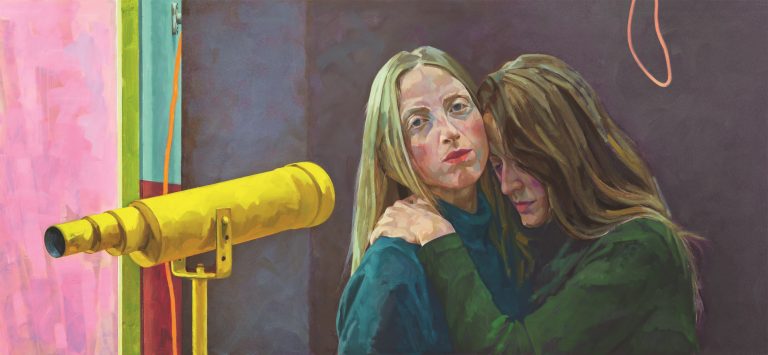
Xenia Hausner, Unintended Beauty, 2022, oil on paper on Dibond, 118 x 255 cm; 46 1/2 x 100 1/2 in. Photo: Bruno Klomfar
The world that Hausner paints is ours. And the deep mysteries of our existence speak from the cryptic arrangements of her paintings.
Daniel Kehlmann, 2020
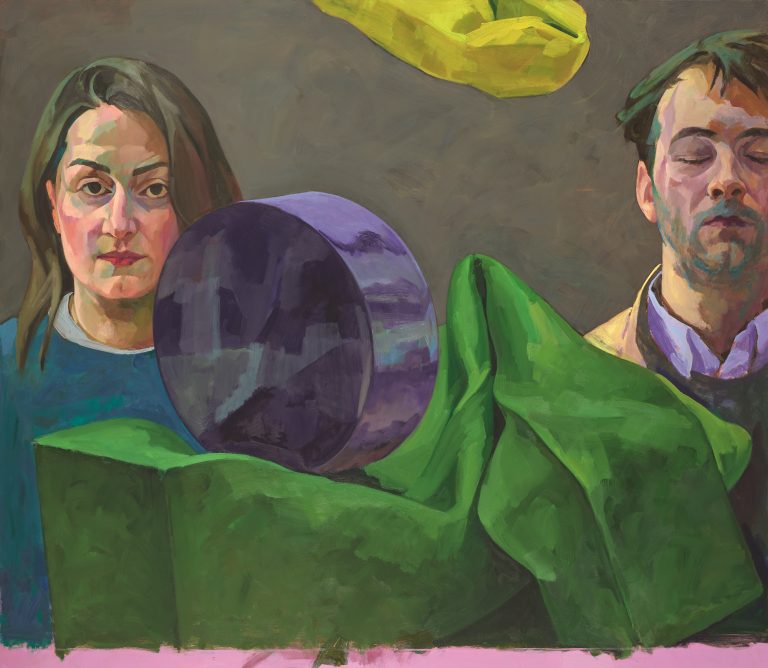
Xenia Hausner, Marriage Story, 2022, acrylic, oil on Dibond, 139 x 159 cm; 54 3/4 x 62 2/3 in. Photo: Stefan Liewehr
KÖNIG GALERIE is pleased to present UNINTENDED BEAUTY, a solo show by one of Austria’s foremost contempo- rary painters, Xenia Hausner.
Xenia Hausner explores the question of beauty. Her latest show comprises twelve new paintings by the Berlin- and Vienna-based artist and is entitled UNINTENDED BEAUTY. Hausner looks at how beauty and the coincidental com- bine in contemporary art. But underpinning her current exhibition is also the question of how beauty and dread relate to each other. The distinction between them is fluid. “Every angel is terrifying,” says the often-cited line from Rilke’s Duino Elegies (1912-1922). “For beauty is nothing but the start of terror, that we are still able to bear, and we revere it so, because it calmly disdains to destroy us.” Hauser adapts Rilke’s words for her own purposes, suggesting that “in art, terror is nothing but the start of beauty”. From the apocalyptic murmurings there suddenly rises a glimmer of hope; prophecies of destruction are countered with the inventiveness and power of art.
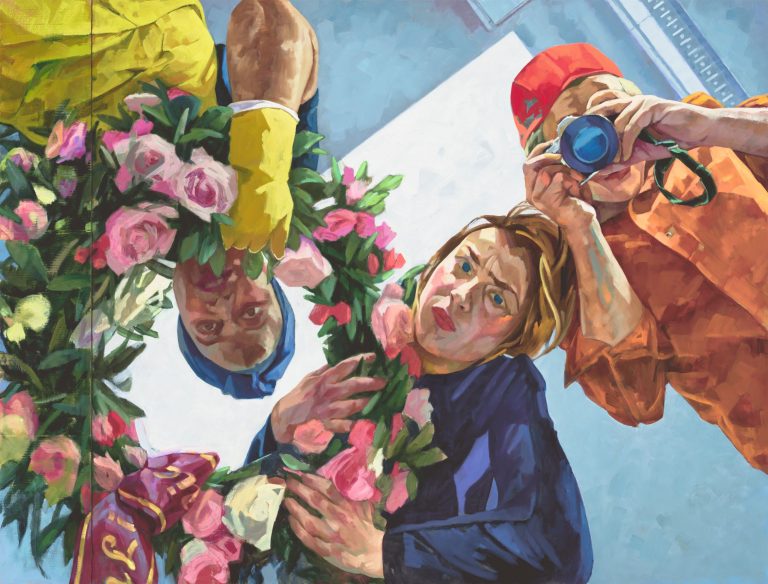
Xenia Hausner, With Love, Xenia, 2022, oil on paper on Dibond, 190 x 250 cm; 74 3/4 x 98 1/2 in. Photo: Bruno Klomfar
The world of Xenia Hausner is populated by women with challenging gazes. If anyone is looking for feminine self-confidence—they will find it here.
Eva Menasse, 2020
Chance moments are written into Hausner’s art alongside conscious mises-en-scène. But Hausner – who uses pho- tography and interior settings to produce her art – does not set out to distort her co-actors. Quite the opposite, in fact: the artist says that she attaches great importance to “the figures retaining their authentic body language”. Yet at the same time, Hausner adds, the people she paints are also “like actors playing a part in my story”. The traditional, subtle power relations between painter and subject, then, become a bi-directional exchange, with each side reveal- ing aspects of themselves. “Painting has to do with affection,” says Hausner. Her images, painted in acrylics and oils on Dibond sheet, show her particular interest in composition, light and the power of colours. Thus, even supposedly secular subjects, such as buoys in a harbour basin, or politically representative, highly charged image media such as postage stamps can become a playing field for painterly and social questions. They are dropped like anchors into the depths of a semi-conscious story that may contain elements of autobiographical scenes, or “questionable idylls”, as the artist calls them.
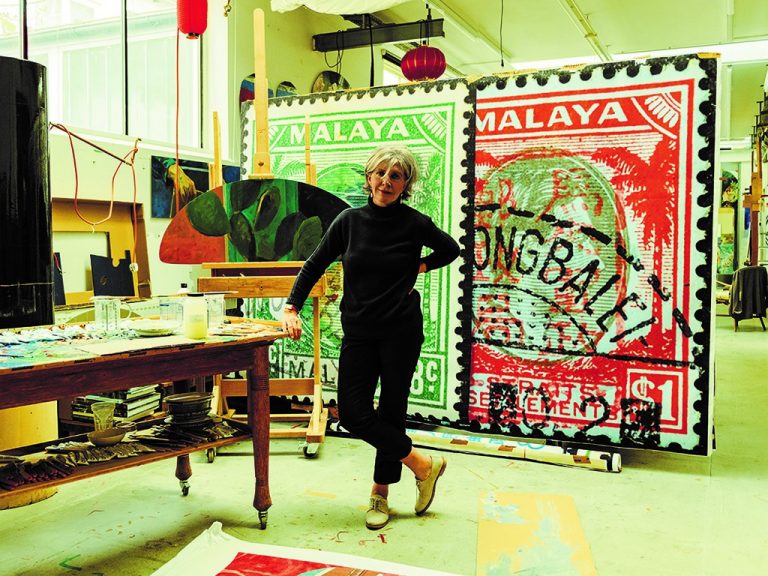
In Vienna Studio © Studio Xenia Hausner. Photo: Robert Rieger for Egon Zehnder
UNINTENDED BEAUTY poses a contradiction to our zeitgeist, as Hausner’s pictures hold on to beauty. Subjected to affirmative slickness, says the philosopher Byung-Chul Han, beauty is useless to art, because art needs friction and negativity. The cultural critic Laurie Penny commented on the toxic-normative core underlying this slickness quite some time ago, saying that every day, women are bombarded by films, TV, ads, print media and even fleeting encoun- ters and their more or less subtle messages that they are not young, slim, light-skinned or submissive enough. And yet the actors in Hausner’s predominantly female cosmos appear to represent a counter-world that draws its aesthetic power from everyday reality. They are depicted as confident and fully occupying the space. So, could this be a way of defending beauty through the medium of art? These paintings are dialectically close to reality but also utopian.
Text by Kito Nedo
Xenia Hausner (born 1951) lives and works in Vienna and Berlin. The Museum Franz Gertsch in Burgdorf, Switzerland, is currently showing a retrospective previously presented at the Albertina in Vienna and the Pushkin Museum in Mos- cow (2021). Hausner has presented other solo shows in the Palais Populaire, Berlin (2020); the Austrian Cultural Forum, New York (2019); the Palazzo Ducale di Mantova, Mantua (2019); the Danubiana Meulensteen Art Museum, Bratislava (2018); the Today’s Art Museum, Beijing (2014); the Hong Kong Arts Center, Hong Kong (2014) and elsewhere. Hausner was also part of Glasstress, a collateral event accompanying the 27th Venice Biennale in the Palazzo Franchetti, Venice (2017); the 8th Moscow Biennale at the State Tretjkov Galerie, Moscow (2019); and the Bienalsur, South America’s Art Biennale 2019, in Cúcuta, Colombia (2019).
Zhanna Kadyrova
Palianytsia
When we arrived, we stayed in a crowded and expensive hotel in the centre of town. To find another place to stay, we had been travelling a lot in the area. During this search, we became aware of the river stones, took a closer look at them, and the idea came to us by itself. We didn’t have time to analyse; we had a growing need to do something and be useful.
Zhanna Kadyrova, 2022
KÖNIG GALERIE presents PALIANYTSIA, a solo exhibition by Ukrainian artist Zhanna Kadyrova in the CHAPEL of ST. AGNES.
Kadyrova works in a variety of disciplines such as sculpture, photography, video and performance. Her practice is often site-specific and informed by the malleable and symbolic properties of urban building materials. Collecting stones from her nearest river in western Ukraine, Kadyrova’s sculptures, drawings and short film, take on the urgent situation currently playing out in her home country.
Before the Russian war of aggression on Ukraine began, Kadyrova was based in Kiev. Due to the ongoing conflict she fled to the western part of the country. After relocating to the Transcarpathian region, the artist began her latest series which culminated in the PALIANYTSIA project, co-authored by Denis Ruban.
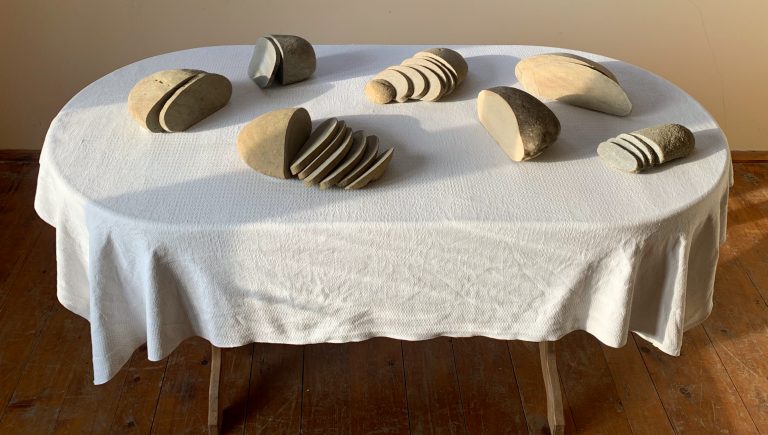
Zhanna Kadyrova, Palianytsia, 2022. Found river stone. Variable dimensions. Courtesy of the artist and Galleria Continua. Photo: Ivan Sautkin
Palianytsia is the name of a Ukrainian round wheat bread that Russian occupiers cannot pronounce correctly and there- fore acts as a password or recognition mark among Ukrainians. During her days-long search for accommodation and a functioning studio, Kadyrova collected round stones polished smooth by the river’s current. As a symbol of Ukrainian resistance, she produced this series of illusory sculptures by slicing these collected stones whose form take on that of the Palianytsia bread.
“During the first two weeks of the war, I had the impression that art was only a dream, that I had only dreamed these twenty years of my professional life. And that art at all is powerless and ephemeral compared to the ruthless machinery of war that destroys civilian cities and human lives,” the artist states. “Today I don’t think that way anymore, and I see that every artistic gesture makes us visible, and our voices audible!”
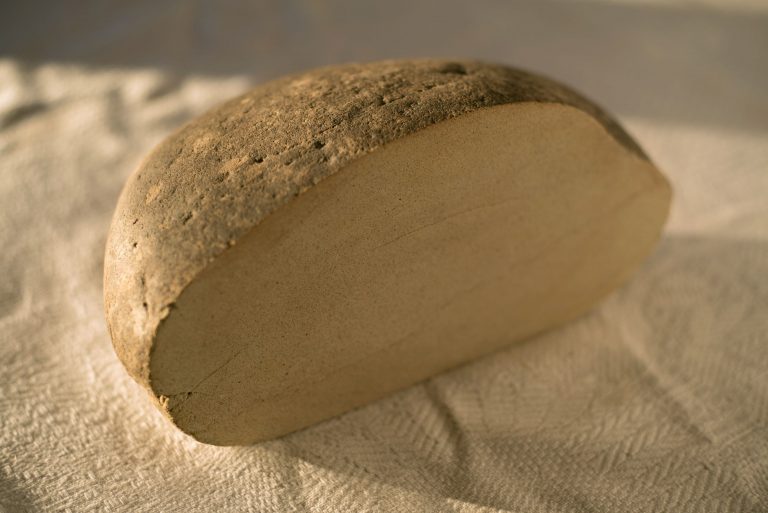
Zhanna Kadyrova, Palianytsia, 2022. Found river stone. Variable dimensions. Courtesy of the artist and Galleria Continua. Photo: Ivan Sautkin
Kadyrova has previously presented these sculptures and drawings in her temporary accommodation in Ukraine. With the proceeds from the sold works, she supplied herself and others with bullet-proof waistcoats, petrol, food, and med- icine. She has also supported people in need in Kiev and different volunteer organisations in Kharkiv and Mariupol. The short film screened in the exhibition space, documents the creation of the shown works in Transcarpathia and gives insight into the everyday life of Kadyrova and her colleagues under the impression of the war. It was directed and produced by members of the Ukrainian cinematographic community, Babylon’13, and in collaboration with UA-Cul- ture: Ivan Sautkin, Olena Zashko, and Ganna Yeresko.
During the first two weeks of the war, I had the impression that art was only a dream, that I had only dreamed these twenty years of my professional life. And that art at all is powerless and ephemeral compared to the ruthless machinery of war that destroys civilian cities and human lives. Today I don’t think that way anymore, and I see that every artistic gesture makes us visible, and our voices audible!
Zhanna Kadyrova, 2022
Zhanna Kadyrova (b. in 1981 in Brovary, Ukraine) is a member of the Ukrainian artist group “R.E.P.” (Revolution Exper- imental Space). The artist’s first major retrospective was scheduled by PinchukArtCentre in Kyiv for 2023. Her works have been shown internationally in solo exhibitions, including the Ukrainian Institute, New York (2020); at the Villa Pac- chianiCentroEspositivo,SantaCrocesull’Arno,Pisa;andtheFondazioneMACC,Sardinia(both2019); Бükü–Bureau for Cultural Translations, Leipzig (2016); and Kunstraum Innsbruck (2015).
Kadyrova was part of group shows worldwide, including the Art Centre Silkeborg Bad, Silkeborg (2022); the M17 Con- temporary Art Centre, Kyiv (2021); Marta Herford Museum, Herford (2021); the Shanghai International Sculpture Pro- ject JISP, Shanghai (2020); and Kunsthalle Mulhouse (2020). She participated at the 58th, 56th and 55th Venice Bienni- als (2019, 2015 and 2013); the 33rd Biennial of Graphic Arts in Ljubljana (2019); and the Kyiv Biennale (2017).
The artist was honoured by the PinchukArtCentre, Kyiv, with the Special Prize (2011), the Main Prize (2013) and the Special Prize – Future Generation International (2014). She also received the Kazimir Malevich Artist Award, and the Grand Prix of the Kyiv Sculpture Project (both 2012).
